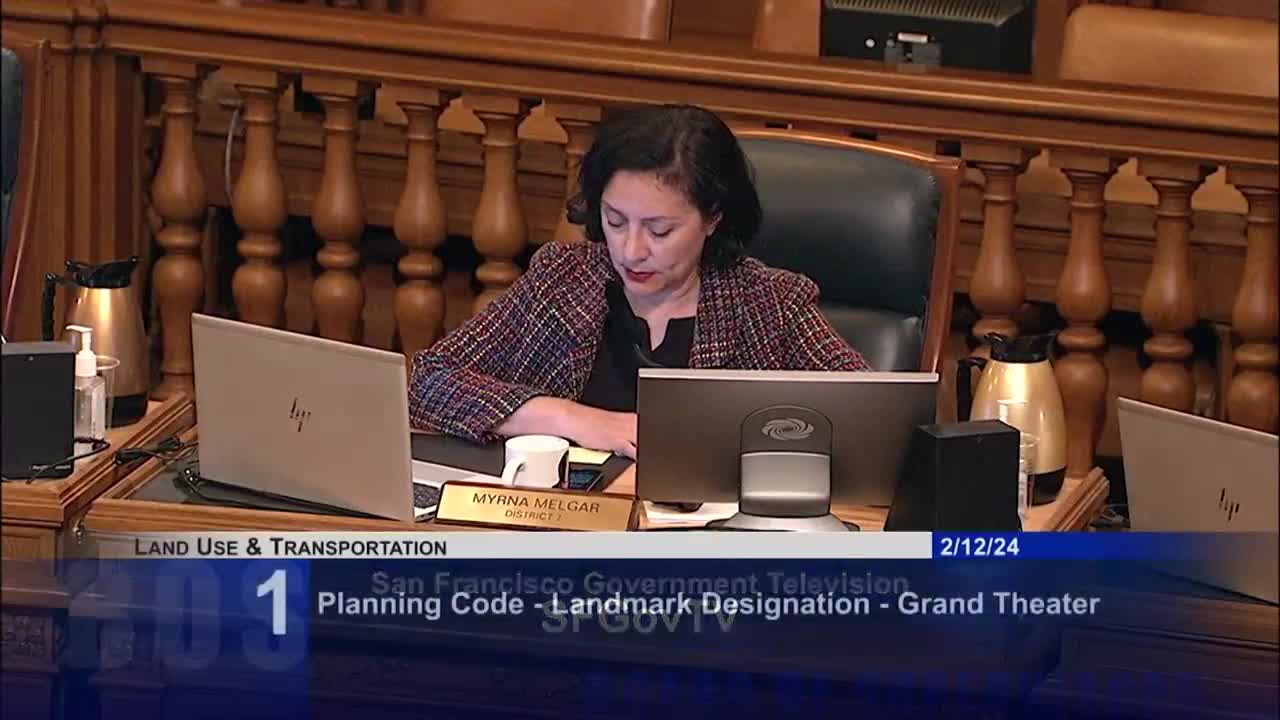San Francisco Planning Commission designates Grand Theater as landmark for community preservation
February 12, 2024 | San Francisco County, California

This article was created by AI summarizing key points discussed. AI makes mistakes, so for full details and context, please refer to the video of the full meeting. Please report any errors so we can fix them. Report an error »

In the heart of San Francisco's Mission District, the historic Grand Theater stands as a beacon of community spirit and cultural heritage. During a recent government meeting, city officials gathered to discuss a significant ordinance aimed at designating the Grand Theater as a landmark, ensuring its preservation for future generations.
Anna Herrera, representing Supervisor Ronan's office, passionately advocated for the theater's landmark status, highlighting its importance as a cherished community asset. "The Grand Theater has been a vital part of our neighborhood, serving working-class families since its inception," she stated. The theater, which has survived the fate of many of its counterparts—demolition or conversion into parking lots—has remained a hub for local arts, thanks to the stewardship of the Gray Area Foundation for the Arts.
Established a decade ago, Gray Area has transformed the Grand Theater from a neglected space into a thriving cultural center. They have hosted numerous events, supported local and BIPOC artists, and recently raised over $50,000 to restore the theater's iconic neon marquee. "This landmark designation is crucial for maintaining the momentum of our community's cultural resource," Herrera emphasized.
Pilara LaValley from the Planning Department provided further context, noting that the Grand Theater, designed by renowned architects G. Albert Landsberg and S. Charles Lee, was the last movie theater built in San Francisco before World War II. Its architectural significance and historical ties to the neighborhood's vibrant theater scene were underscored during a public hearing by the Historic Preservation Commission, which unanimously recommended the landmark designation.
Barry Thru, Executive Director of Gray Area, echoed these sentiments during public comments, detailing the theater's transformation and its role in generating local economic benefits. "Our cultural usage of the Grand Theater generates 137 jobs and contributes significantly to local income and tax revenue," he explained. Thru emphasized that the Grand is one of only two remaining theaters on Mission Street still serving its original purpose, making its preservation all the more critical.
As the meeting progressed, the support for the Grand Theater's landmark status grew, reflecting a collective commitment to safeguarding San Francisco's cultural heritage. The discussions not only highlighted the theater's historical significance but also its ongoing role as a vibrant community space, ensuring that the spirit of the Mission District continues to thrive. The future of the Grand Theater now rests in the hands of city officials, who will decide whether to uphold this vital piece of San Francisco's history.
Anna Herrera, representing Supervisor Ronan's office, passionately advocated for the theater's landmark status, highlighting its importance as a cherished community asset. "The Grand Theater has been a vital part of our neighborhood, serving working-class families since its inception," she stated. The theater, which has survived the fate of many of its counterparts—demolition or conversion into parking lots—has remained a hub for local arts, thanks to the stewardship of the Gray Area Foundation for the Arts.
Established a decade ago, Gray Area has transformed the Grand Theater from a neglected space into a thriving cultural center. They have hosted numerous events, supported local and BIPOC artists, and recently raised over $50,000 to restore the theater's iconic neon marquee. "This landmark designation is crucial for maintaining the momentum of our community's cultural resource," Herrera emphasized.
Pilara LaValley from the Planning Department provided further context, noting that the Grand Theater, designed by renowned architects G. Albert Landsberg and S. Charles Lee, was the last movie theater built in San Francisco before World War II. Its architectural significance and historical ties to the neighborhood's vibrant theater scene were underscored during a public hearing by the Historic Preservation Commission, which unanimously recommended the landmark designation.
Barry Thru, Executive Director of Gray Area, echoed these sentiments during public comments, detailing the theater's transformation and its role in generating local economic benefits. "Our cultural usage of the Grand Theater generates 137 jobs and contributes significantly to local income and tax revenue," he explained. Thru emphasized that the Grand is one of only two remaining theaters on Mission Street still serving its original purpose, making its preservation all the more critical.
As the meeting progressed, the support for the Grand Theater's landmark status grew, reflecting a collective commitment to safeguarding San Francisco's cultural heritage. The discussions not only highlighted the theater's historical significance but also its ongoing role as a vibrant community space, ensuring that the spirit of the Mission District continues to thrive. The future of the Grand Theater now rests in the hands of city officials, who will decide whether to uphold this vital piece of San Francisco's history.
View full meeting
This article is based on a recent meeting—watch the full video and explore the complete transcript for deeper insights into the discussion.
View full meeting
